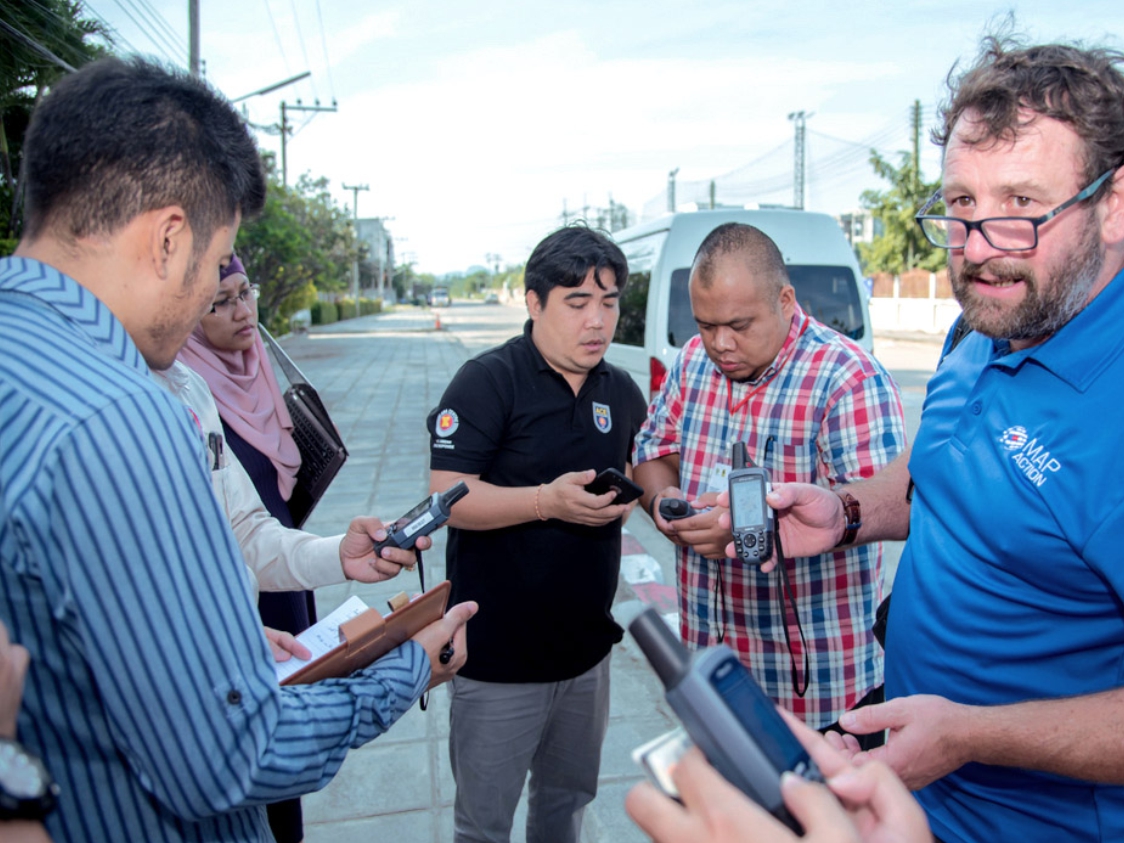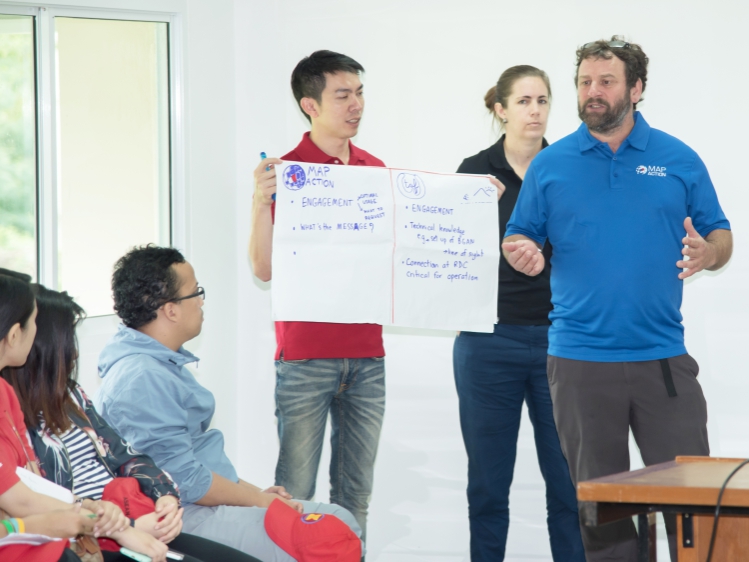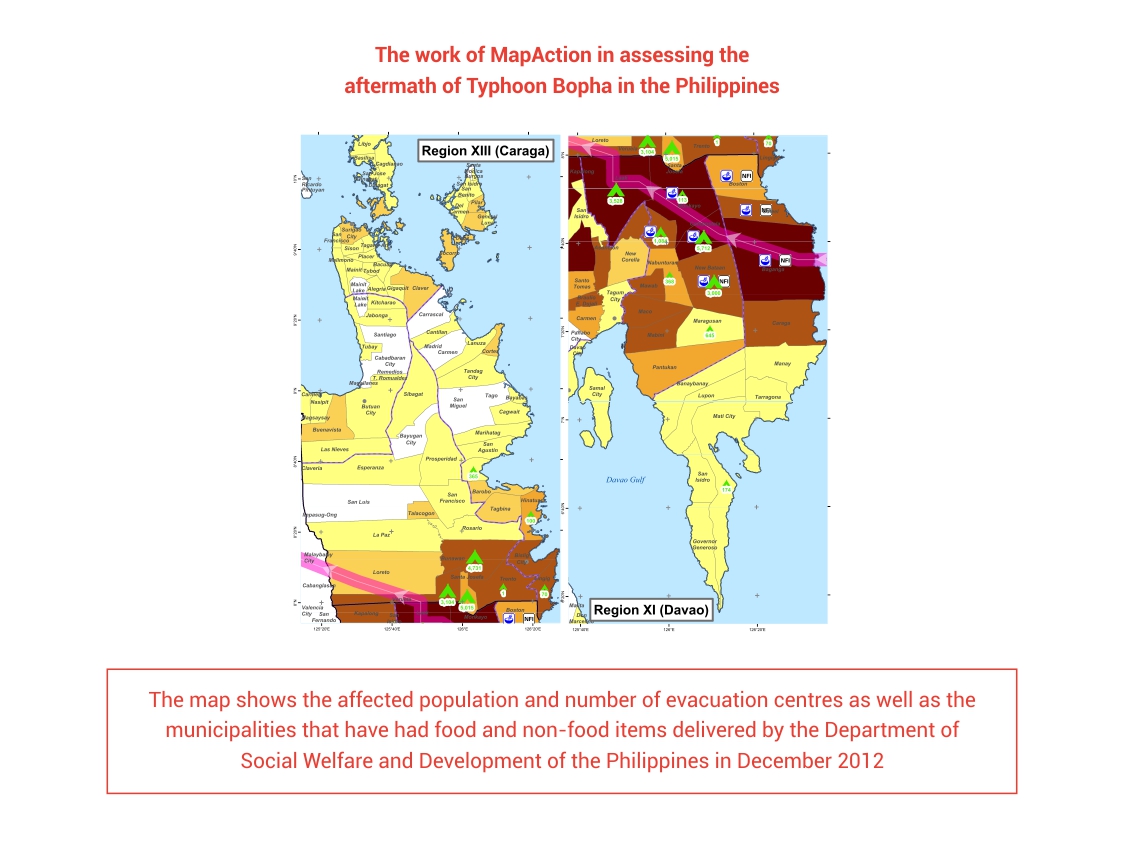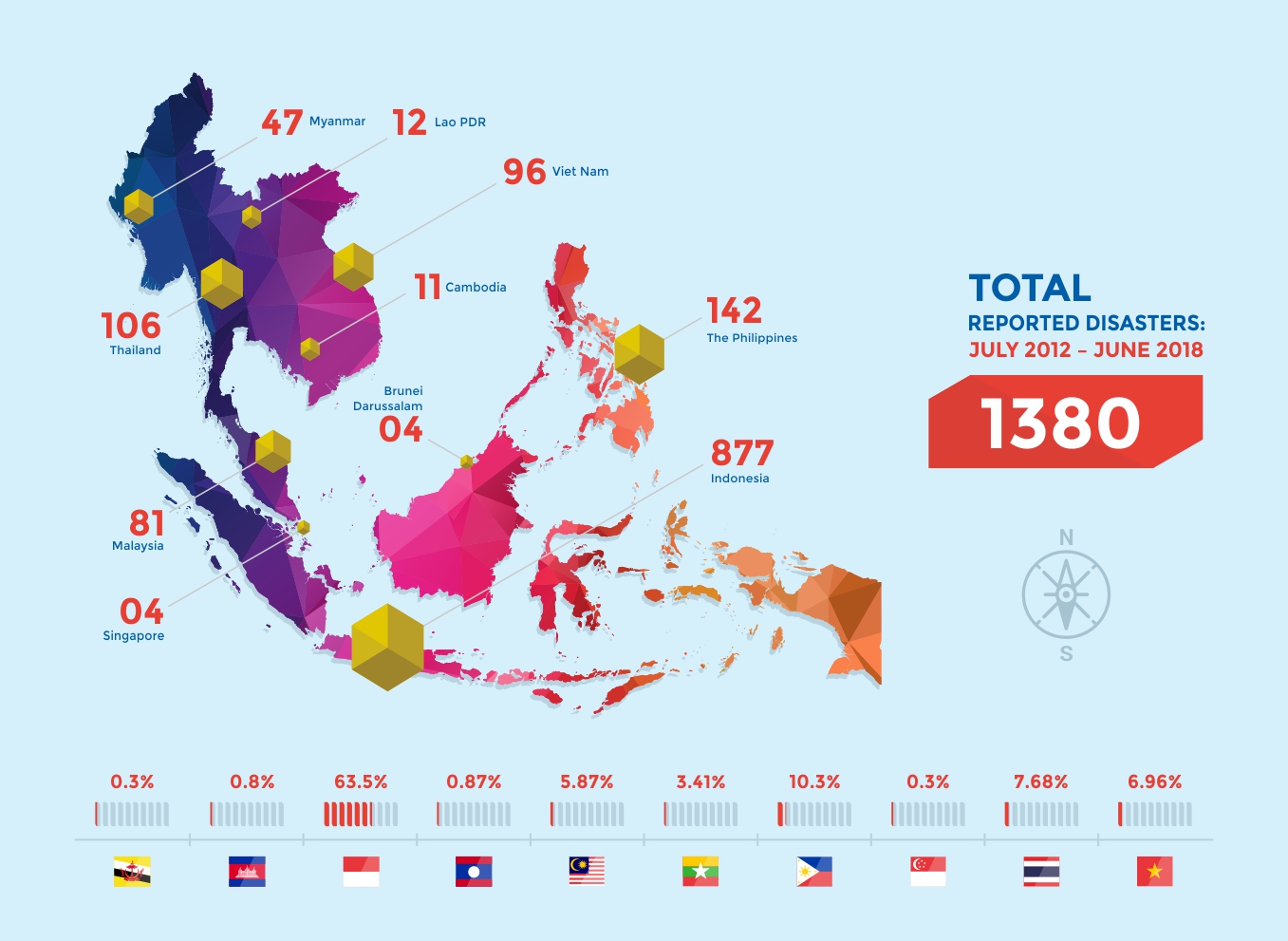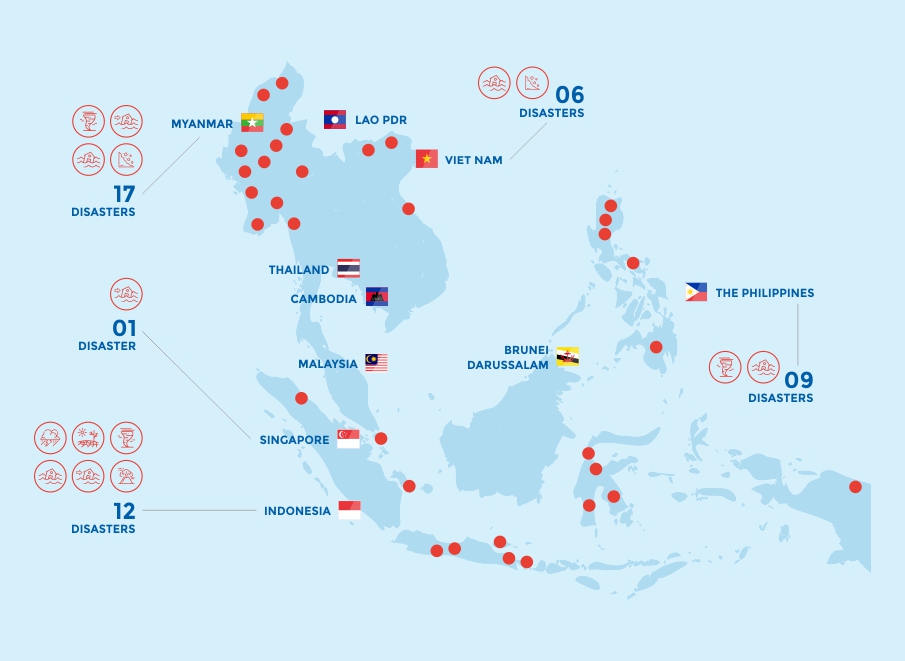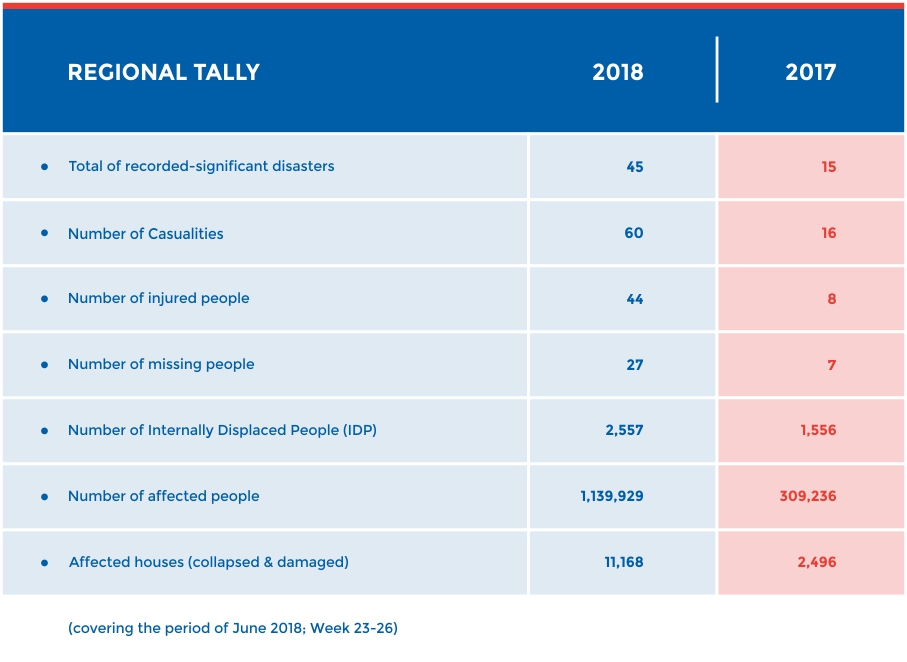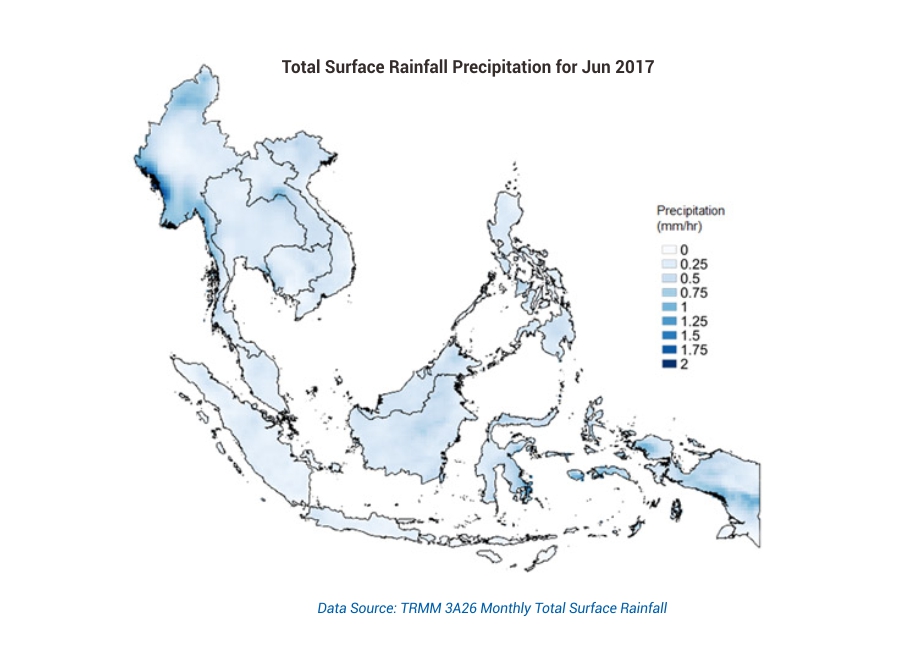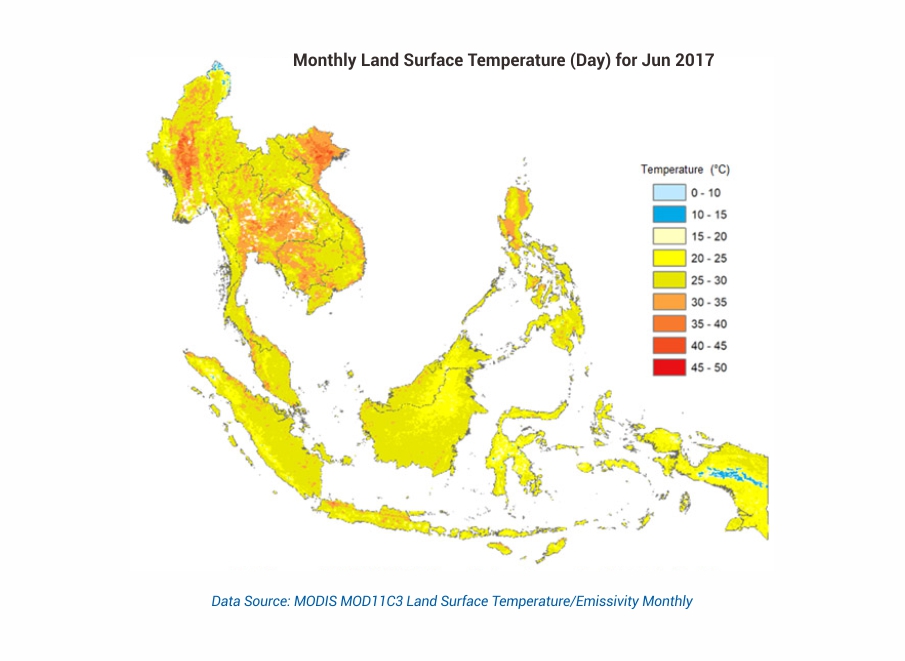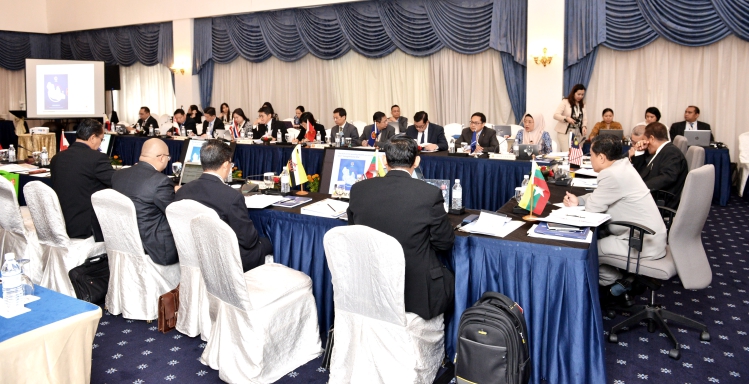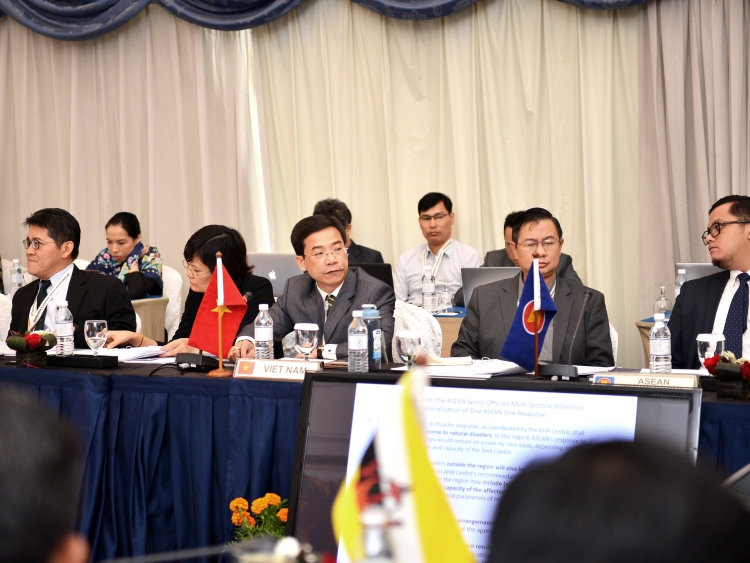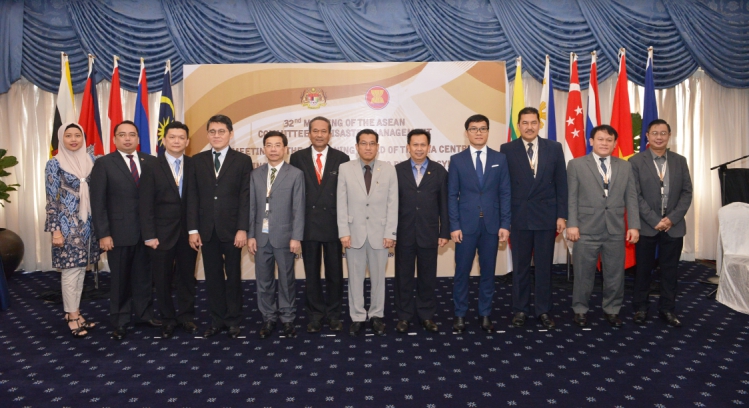Vol 40-MAP Action

MAPACTION
Mapping is perhaps one of the first things that springs to mind when we think of disaster preparedness and response. It forms an integral element of determining affected areas, infrastructure and terrain, as well as access for supplies both in preparedness planning and when disaster strikes. MapAction has been supporting the emergency management sector with professional mapping services, sending teams to respond to around 80 disasters across the world, and impacting the lives of tens of millions since its establishment in 2002. Based on such experience, and the importance of mapping within the disaster management context, the AHA Centre and MapAction recently formalised their working partnership through the signing of a Memorandum of Intent (MoI) during the 8th Meeting of the Governing Board of the AHA Centre held in Kuala Lumpur, Malaysia, on 27 June 2018.
Although the ink is still drying on the formal partnership between the AHA Centre and MapAction, the two institutions have already forged a strong working relationship throughout recent years, primarily engaging through the AHA Centre-led ASEAN Emergency Response and Assessment Team (ASEAN-ERAT) training programme. MapAction has provided valuable support to participants in the ASEAN-ERAT workshops, with hands-on training using state-of-the-art mapping applications that support the work of ASEAN-ERAT during disaster response. Training on the use of these applications has allowed ASEAN-ERAT members to engage in data visualisation and communication of the impacts of disasters during deployments on the frontline, and such working efforts paved the way for the development of the AHA Centre and MapAction’s formal partnership.
This recently signed MoI will ensure that a range of activities will be undertaken with a focus to mutually-beneficial outcomes for both the AHA Centre and MapAction. Under the MoI, MapAction will engage their skills and experience to support the development and implementation of emergency management in the region by providing GIS-based mapping support for ASEAN-ERAT deployments to regional and international emergency response operations, as well as providing GIS-based remote mapping material support for the AHA Centre upon request. Accordingly, the AHA Centre will support MapAction’s work by facilitating access to disaster-affected areas, including obtaining visas and customs clearance for MapAction’s equipment, and also identifying and facilitating potential collaboration opportunities between ASEAN Member States and MapAction to enhance information management and the use of GIS in emergency preparedness and response efforts.
The two parties will also embark on a range of shared projects, with the aim to strengthen the long-term sustainability and development of disaster management capacity in the ASEAN region. Such efforts will include a jointly-developed training curriculum for an ASEAN-ERAT specialised course on GIS mapping and technology, alongside practising joint deployment within the ASEAN Regional Disaster Emergency Response Simulation Exercise (ARDEX) and ASEAN Regional Forum Disaster Relief Exercise (ARF DiREx) implementations. Such mutually-beneficial partnerships form a key element of the AHA Centre’s partnership strategy, as summed up by the AHA Centre’s Executive Director Ms. Adelina Kamal,
“The knowledge and practical skills shared by MapAction through joint training and exercises will allow the AHA Centre and our ASEAN-ERAT members to better assist the disaster-affected country and enhance coordination with other humanitarian actors in line with the spirit of One ASEAN One Response.”
Written by : William Shea | Photo : AHA Centre, MapAction
- Published in Partnership
Vol 40-Total Reported Natural Disaster in Southeast Asia

TOTAL REPORTED
NATURAL DISASTERS IN SOUTHEAST ASIA
JULY 2012 – JUNE 2018
The AHA Centre has been monitoring disasters across ASEAN since its establishment in 2011. This month, we present a snapshot from consolidated data of recorded disasters that have taken place in the ASEAN region throughout the past six years.
As can be seen, the occurrence of disaster in Indonesia is extremely high, due much to its location on the ‘Ring of Fire’ – with its high tectonic activity – resulting in ongoing threats from earthquakes and volcanoes, alongside hydro-meteorological events such as flooding and landslides. Nations such as Malaysia, the Philippines, Thailand and Viet Nam have also experienced high numbers of disasters, often as a result of monsoonal seasons and heavy rainfall. Even for nations with lower numbers, the risk of disaster remains high. Due to ongoing optimisation of AHA Centre’s monitoring systems, as well as improving regional disaster classifications and reporting mechanisms, localised disasters may have previously been under-reported, with numbers for many nations potentially higher than displayed above. This highlights the importance of the AHA Centre’s existence, to support the skills development and increase capacity of Member States to prepare, monitor and respond to disasters of all varieties and at a world-class level.
Written by : Shintya Kurniawan, William Shea
DISCLAIMER
The presented information above is consolidated from the ASEAN Disaster Information Net (ADINet) and the Emergency Events Database (EM-DAT).
- Published in Insight
Vol 40-Monthly Disaster Review and Outlook

MONTHLY DISASTER REVIEW AND OUTLOOK
JUNE 2018 | DISASTER MONITORING & ANALYSIS
(DMA) UNIT, AHA CENTRE
GENERAL OVERVIEW OF JUNE 2018
There was a three-fold increase in the number of disasters recorded during June 2018 (45 in total) in comparison to the same time during 2017 (15 disasters). An onset of numerous weather events caused this spike in disasters, with the southwest monsoons, Tropical Depression (TD) Domeng, TD Ewiniar, TD Ester and TS Florita causing floods and landslides throughout the Philippines, Viet Nam and Myanmar. In contrast, several areas south of the equator, particularly Indonesia’s Central Java and Yogyakarta provinces, have experienced the onset of drought conditions, consistent with the shift to the region’s dry season. This such phenomena indicates a similar pattern to 2017, which saw northern parts of ASEAN experiencing wet season floods, while southern parts experienced dry season drought events (see Figure 1) . Overall, 20 flood events, 11 storms and 4 wind-related disasters were recorded throughout June 2018.
In terms of geological hazards, 26 earthquakes registering ≥ M 4.5 were observed across Indonesia and the Philippines. However, only two were strong enough to cause property damage (East Java and Papua provinces of Indonesia, on the 13th and 15th of June respectively. Towards the end of June 2018, concerns were raised due to increased activity reported on Bali’s Mount Agung, which released ash plumes and resulted in a strombolian-type eruption.
OUTLOOK FOR JULY-AUGUST 2018
According to the ASEAN Specialised Meteorological Centre (ASMC), most parts of the ASEAN region will continue to experience wet weather, as the rain band associated with Typhoon Prapiroon affects the region. Hotspot activities have remained subdued, but isolated events have been detected in Viet Nam and Lao PDR. During the first week of July, dry weather is expected to affect Java, and may exacerbate the ongoing drought events. Aside from such southern areas, wet weather is likely to persist over other parts of the ASEAN region. For tropical cyclone (TC) forecasts, the Philippine Atmospheric. Geophysical and Astronomical Services Administration (PAGASA) expects that 10-14 TCs will form and enter the Philippine Area of Responsibility throughout the six months between July and December 2018.
Close and continuous monitoring is still required for Mount Sinabung (Alert Level IV) and Mount Agung (Alert Level III) in Indonesia, particularly due to historic Mount Agung eruptions, which lasted up to one year during 1963-1964.
Written by : Mizan Bisri, Qing Yuan Pang
DISCLAIMER
AHA Centre’s estimation is based on data and information shared by National Disaster Management Organisations (NDMOs) and other relevant agencies from ASEAN Member States, international organisations and news agencies. Further information on each recorded-significant disaster, description and details of data and information are available at: http://adinet.ahacentre.org/reports.
- Published in Monthly Disaster Outlook
Vol 40-The 8th Meeting of The Governing Board of The AHA Centre

THE 8th MEETING OF
THE GOVERNING BOARD OF THE AHA CENTRE
The latest series of meetings of the ASEAN Committee on Disaster Management (ACDM) and the Governing Board of the AHA Centre focused towards the continuing vision of ASEAN nations to become global leaders in disaster management. The meetings discussed a number of ongoing initiatives, as well as past achievements in disaster management, alongside the future disaster management plans for the ASEAN region.
This integral series of meetings was officially opened by Malaysia’s Deputy Prime Minister, the Honourable Dato’ Seri Dr. Wan Azizah binti Wan Ismail, who commended ASEAN on its various achievements in disaster management, while also reiterating the work that still must be done. She highlighted particular concerns regarding the plight of women during disaster situations, calling on ASEAN nations to continue efforts to mainstream gender within disaster management efforts.
Achievements highlighted by the Governing Board included the decision that the AHA Centre would provide humanitarian assistance support to the survivors of human-induced disasters. Throughout 2017, and continuing into 2018, the AHA Centre provided humanitarian assistance to displaced populations in Marawi, the Philippines and the Rakhine state, Myanmar. This evidenced the AHA Centre’s efforts to ‘go the extra mile’, as the original mandate of the AHA Centre focuses on providing assistance to victims of natural disasters. In this situation however, the AHA Centre recognised the need to be adaptable and flexible in recognition of the ever-evolving landscape and increasing complexity of disaster management in the region.
During the meeting, ASEAN nations also reaffirmed their commitment to support the operationalisation of One ASEAN One Response Declaration – signed in 2016 – that calls for an increase in speed, scale and solidarity of ASEAN collective response to major disaster within and outside the ASEAN region. The AHA Centre, as the operational engine of the ASEAN Agreement on Disaster Management and Emergency Response (AADMER), has taken a number of initiatives to further enhance the operationalisation of the Declaration, including the formulation of the ASEAN Joint Disaster Response Plan (AJDRP).
Another highlight from the meetings were the various initiatives to improve the capacity of the disaster professionals in the region through various capacity building activities, including the ASEAN Emergency Response and Assessment Team (ASEAN-ERAT) training, as well as the AHA Centre Executive (ACE) Programme. In addition to this, ASEAN is currently working to kick-start the ASEAN Standards and Certification for Experts in Disaster Management (ASCEND). Through this programme, ASEAN aims to set common standards and qualifications for disaster management professionals, as well as develop a standard training curriculum. By agreeing on common standards, ASEAN will ensure the availability of qualified disaster management professionals in the region, further supporting the vision of ASEAN becoming a global leader in disaster management.
On the side-lines of the event, the Governing Board also witnessed the signing of three Memoranda of Intent (MoI) between the AHA Centre and key strategic partners – namely MERCY Malaysia, RedR Australia and MapAction.
These MoI signings signify the commitment between AHA Centre and the partners to further strengthen, compliment and support each other in areas of mutual interest on disaster management. Several areas covered under the MoIs include knowledge exchange and management, innovation and joint fundraising efforts, disaster monitoring and analysis, and recovery.
All of these were discussed during the 32nd Meeting of the ACDM and other related meetings that took place from the 26th to the 28th of June 2018, in Kuala Lumpur, Malaysia. This also included the 8th Meeting of the Governing Board of the AHA Centre on the 27th of June, the 9th Meeting of the Joint Task Force to Promote Synergy Other Relevant ASEAN Bodies on Humanitarian Assistance and Disaster Relief (HADR), and the 5th ASEAN Agreement on Disaster Management and Emergency Response (AADMER) Partnership Conference. During this event, the AHA Centre also presented its 2017 Annual Report, which documents the progress, achievements, and plans for further enhancement of the roles and responsibility of the AHA Centre.
Written by: Carla Budiarto, Dipo Summa | Photo: AHA Centre
- Published in Highlight
- 1
- 2

